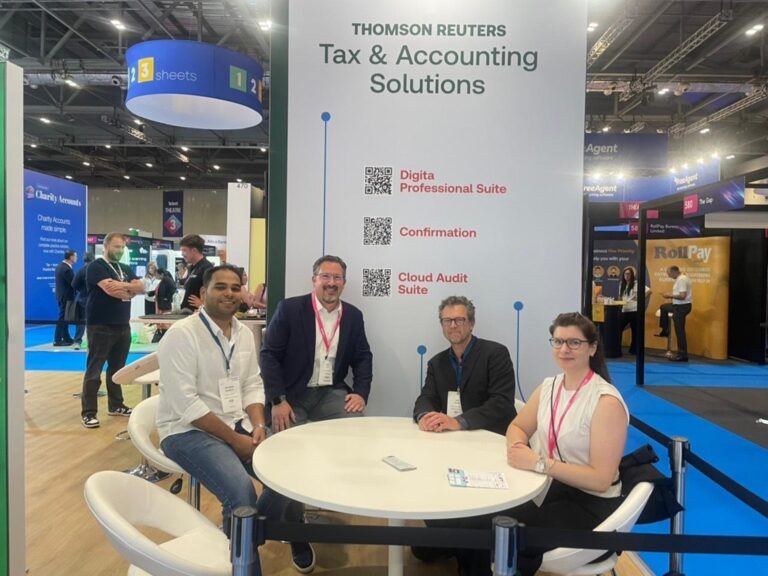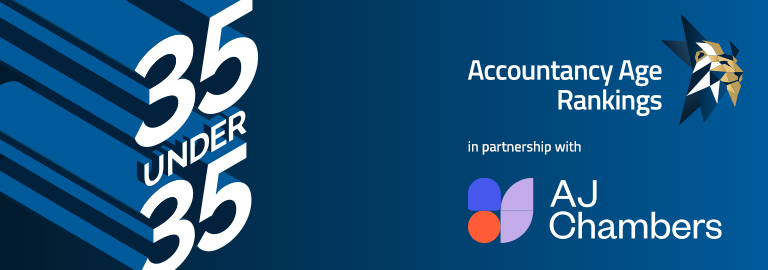It’s one thing to talk about Making Tax Digital (MTD) in theory. It’s another to witness, up close, how the profession is—or isn’t—preparing for it.
At the sidelines of Accountex 2025, we sat down with Thomson Reuters’ Max Thomas (Director of Portfolio), Brian Wilson (General Manager, Tax), and Sai Charan Anaparthy (Product Manager) to hear how they’re interpreting the moment.
The conversation revealed a rare blend of candour and clarity: MTD is coming. Firms know it. But many still don’t know what to do next.
“I’m still astonished by the lack of understanding or preparedness,” Thomas said. “Everybody believes it’s going to happen—but they’re still not ready.”
The MTD narrative has hovered over the UK tax profession for years, but Accountex 2025 marked a turning point: where past scepticism has turned to urgency.
“We had a booth over here with an MTD demo running all day, and it was pretty much jammed,” Anaparthy noted. “Now it’s all about MTD.”
The surge in interest isn’t theoretical. It’s rooted in deadlines. With the first round of quarterly filings due in mid-2025, practices are suddenly facing the granular reality of implementation—client by client, system by system. And, crucially, submission by submission.
Thomson Reuters isn’t just building for that pressure. They’ve been living in it for years.
According to Anaparthy, the team has spent the past three years refining its pilot product, hosting joint events with HMRC, and setting up a robust schedule of fortnightly webinars to prepare its user base. The team has published white papers, run in-person workshops, and created escalation paths directly to HMRC for partner firms.
“We’re now between HMRC and the customer,” he explained. “So if there’s a problem, we can get it resolved quickly. That kind of relationship takes time to build.”
Wilson sees that bridge role as pivotal. “We’re not just explaining the software—we’re helping firms figure out what MTD actually means for their workflows, for pricing, and for how they engage with clients.”
It’s that last point—the client-practice relationship—that may define MTD’s biggest long-term impact.
“Some clients will do it themselves. Others will hand in a spreadsheet. Others will expect the accountant to handle everything,” Thomas said. “The firm has to manage all those scenarios. And they need to figure out which ones are profitable.”
Here, the tone shifted. MTD isn’t just a compliance burden. It’s a catalyst for structural change. Pricing models. Software preferences. Staffing allocations. All of it is up for review. “Firms need to ask: are we spending more time doing this? Are we charging accordingly? Is this profitable?” Wilson said.
And the software? Thomson Reuters has positioned itself to offer what many others can’t: a flexible platform that adapts to the firm’s needs, not the other way around.
Anaparthy pointed out that their system can import data from third-party software, track external filings, and support a wide range of income types—including niche cases that often trip up competitors.
“We’re not telling our customers how to work,” he said. “We’re building software that fits the way they already do.”
One key differentiator: the internal tax engine. Unlike many vendors who rely on HMRC’s outputs, Thomson Reuters has developed its own calculation tools—a move that’s proving essential as HMRC shifts away from providing full tax calcs under MTD.
“That’s going to cause a lot of pain for software providers who don’t have that capability,” Anaparthy said.
And then there’s the question of depth. Some vendors are targeting the 80% use cases—standard scenarios, clean data.
But Thomson Reuters is thinking about the exceptions: the life insurance gains, the multi-property landlords, the legacy quirks of the UK tax system that never quite go away. “We don’t want our customers to think twice about onboarding a complex client,” Anaparthy said.
That focus on real-world scenarios has shaped the product roadmap. “We’ve timed a quarterly submission in our software at about 15 minutes,” Anaparthy shared.
“But with features like mapping reuse—where you do it once in Q1 and apply it across future quarters—we’re bringing that down to five.”
The intention is clear: reduce the time spent inside the software, so that firms can spend more time advising, planning, and building client relationships. “That’s where the real value is,” Thomas said.
On the AI front, the team is measured but optimistic. Wilson noted that “everyone’s slapping AI on the box,” but real value will come from precision, predictability, and security.
“Tax is not a place to get things wrong,” Anaparthy said. “There are too many edge cases. So when we look at AI, we ask: what’s the value? Can it do this job better, faster, or more safely?”
They’re experimenting—with category prediction, anomaly detection, and more. But it’s not about shortcuts. “We treat AI like a teammate, not a decision-maker,” Wilson added.
Security is non-negotiable. “This is sensitive client data,” Anaparthy stressed. “So before we move forward with anything AI-related, we look at masking, guardrails, and where the data flows.”
Looking ahead, the team is excited about what comes next. “Our first quarterly MTD filings go live at the end of June,” Thomas confirmed. “We’ve been working towards this for four years. Now it begins.”
They’re not offering sneak previews beyond that—but the implication is clear. With deep product roots, a long-term partnership with HMRC, and a growing MTD customer base, Thomson Reuters is betting not just on compliance—but on helping firms evolve.
“We’ve seen transformations like this before,” Thomas said. “This one just happens to be bigger, faster, and public. And we’re ready.”

